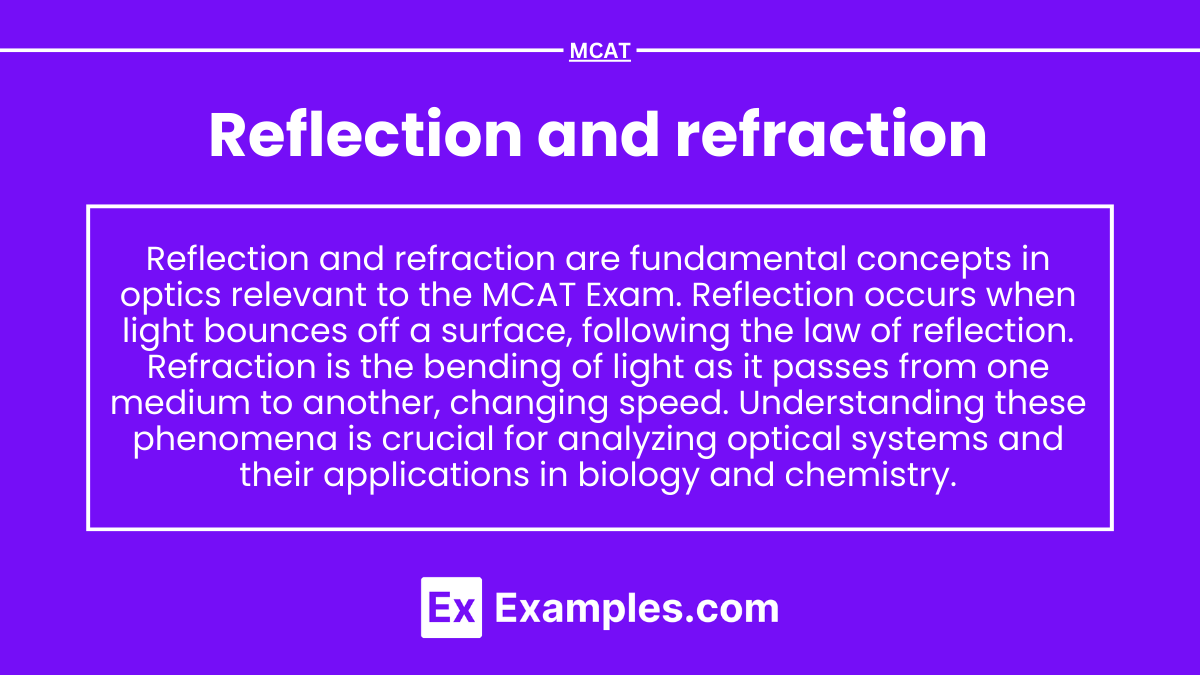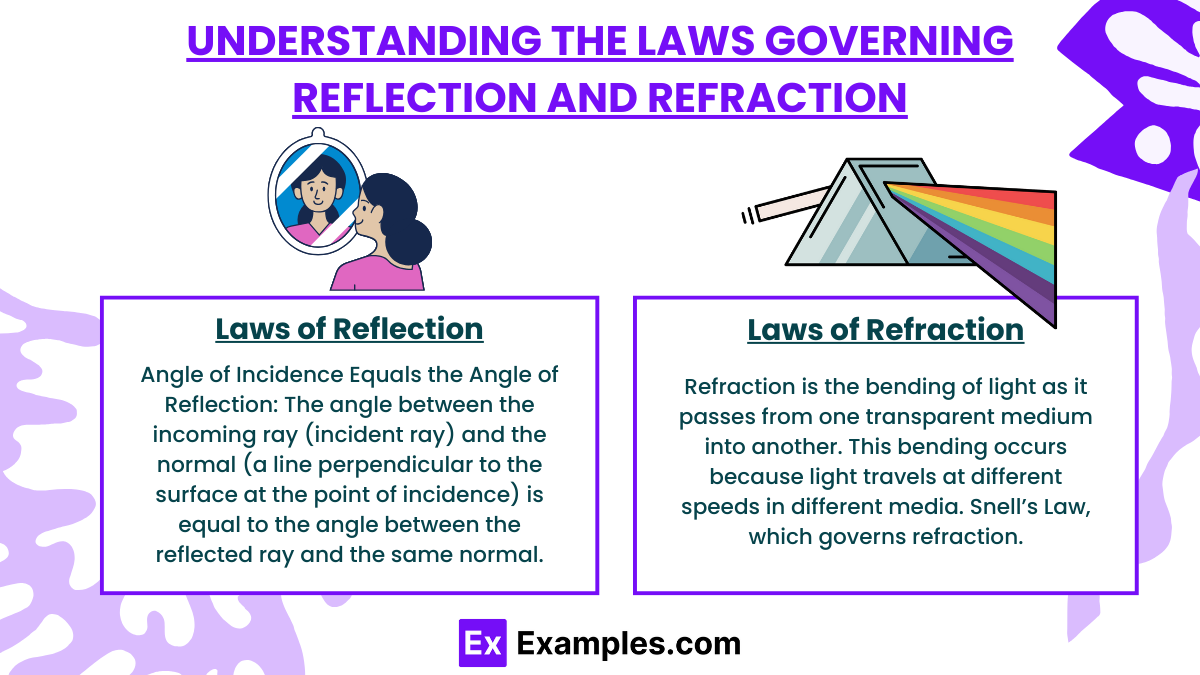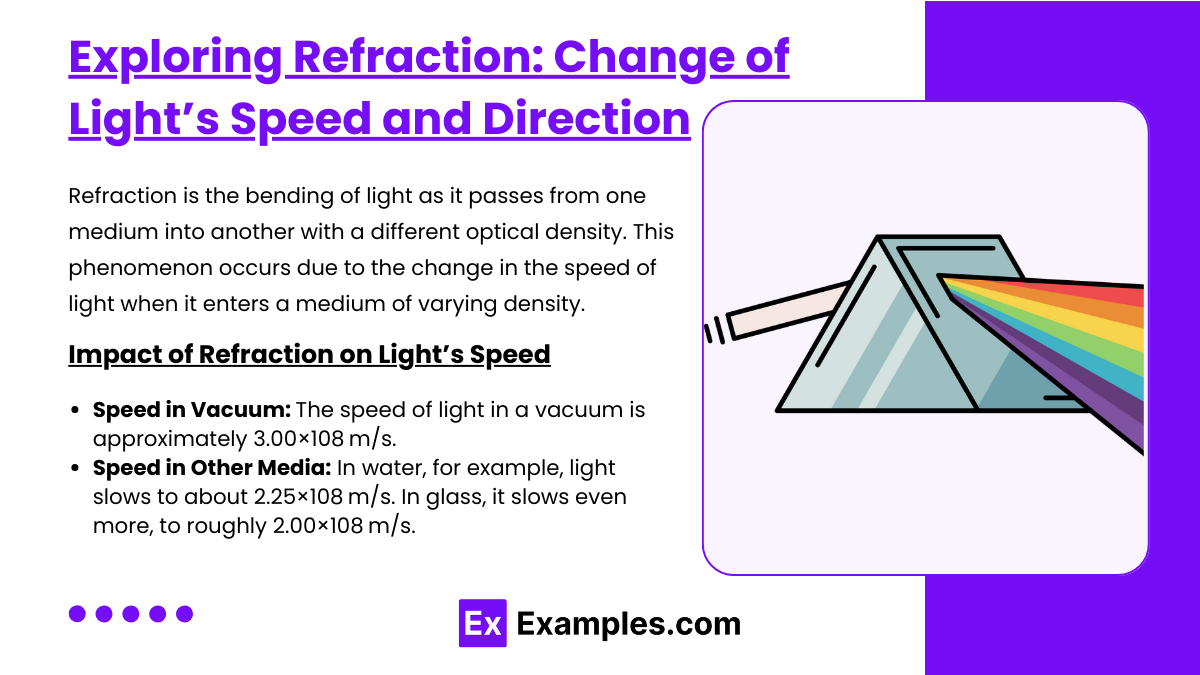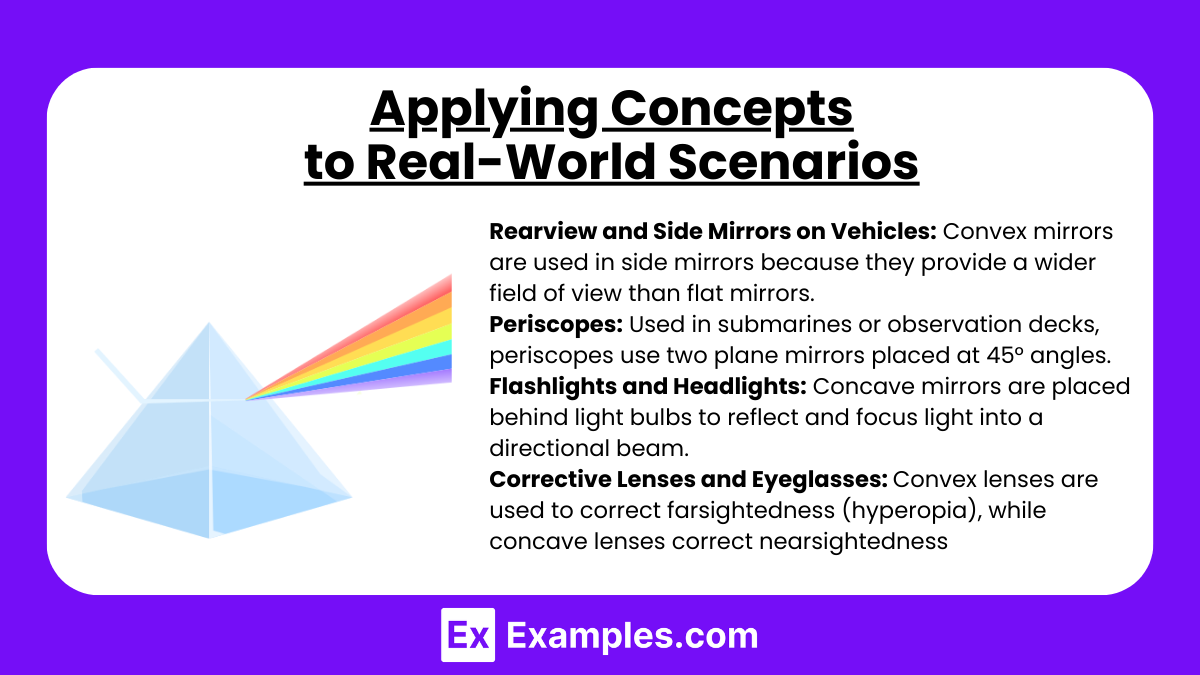Reflection and refraction are fundamental concepts in physics, governing how light interacts with different surfaces and media. On the MCAT, you’ll explore the principles of light behavior, including the laws of reflection, Snell's law for refraction, and critical angles. Understanding the differences between specular and diffuse reflection, total internal reflection, and how light bends through various substances is essential, as these concepts play a key role in mastering physics and optics sections of the exam.
Learning Objectives
In studying "Reflection and Refraction" for the MCAT, you should learn to understand the laws governing both phenomena. In reflection, analyze how the angle of incidence equals the angle of reflection and how different surfaces affect reflected light. In refraction, explore how light changes direction and speed when passing between different media, governed by the refractive index. Evaluate concepts such as total internal reflection and critical angle. Practice solving problems involving Snell's law to predict the behavior of light in lenses and prisms. Additionally, apply these concepts to real-world scenarios, such as vision, fiber optics, and medical instruments, which are essential for MCAT applications.
Understanding the Laws Governing Reflection and Refraction
Reflection and refraction are fundamental optical phenomena governed by specific laws that describe how light behaves when it encounters different media. These laws are essential for designing optical devices and systems, and they explain everyday observations ranging from the appearance of objects in mirrors to the bending of light in water.
Laws of Reflection
Reflection occurs when light rays bounce off a surface. The laws of reflection are quite straightforward:
Angle of Incidence Equals the Angle of Reflection: The angle between the incoming ray (incident ray) and the normal (a line perpendicular to the surface at the point of incidence) is equal to the angle between the reflected ray and the same normal. This is expressed as: θincident = θreflected
Incident Ray, Reflected Ray, and the Normal Lie in the Same Plane: This law states that all three lines (the incident ray, the reflected ray, and the normal) lie in the same plane.
These principles apply to all types of reflecting surfaces, whether flat, concave, or convex, and are the basis for the operation of mirrors and other reflective devices.
Laws of Refraction (Snell's Law)
Refraction is the bending of light as it passes from one transparent medium into another. This bending occurs because light travels at different speeds in different media. Snell’s Law, which governs refraction, can be stated as follows:
Relationship Between Angles and Refractive Indices: The ratio of the sine of the angle of incidence to the sine of the angle of refraction is a constant, depending on the media: sin(θincident)/sin(θrefracted) = n2/n1
Here, n1 and n2 are the refractive indices of the first and second media, respectively.
Direction of Bending:
Light bends towards the normal if it is entering a medium with a higher refractive index (slowing down).
Light bends away from the normal if it is entering a medium with a lower refractive index (speeding up).
Incident Ray, Refracted Ray, and the Normal Lie in the Same Plane: Similar to reflection, all three elements are co-planar.
Analyzing Reflection: Angle of Incidence and Reflected Light
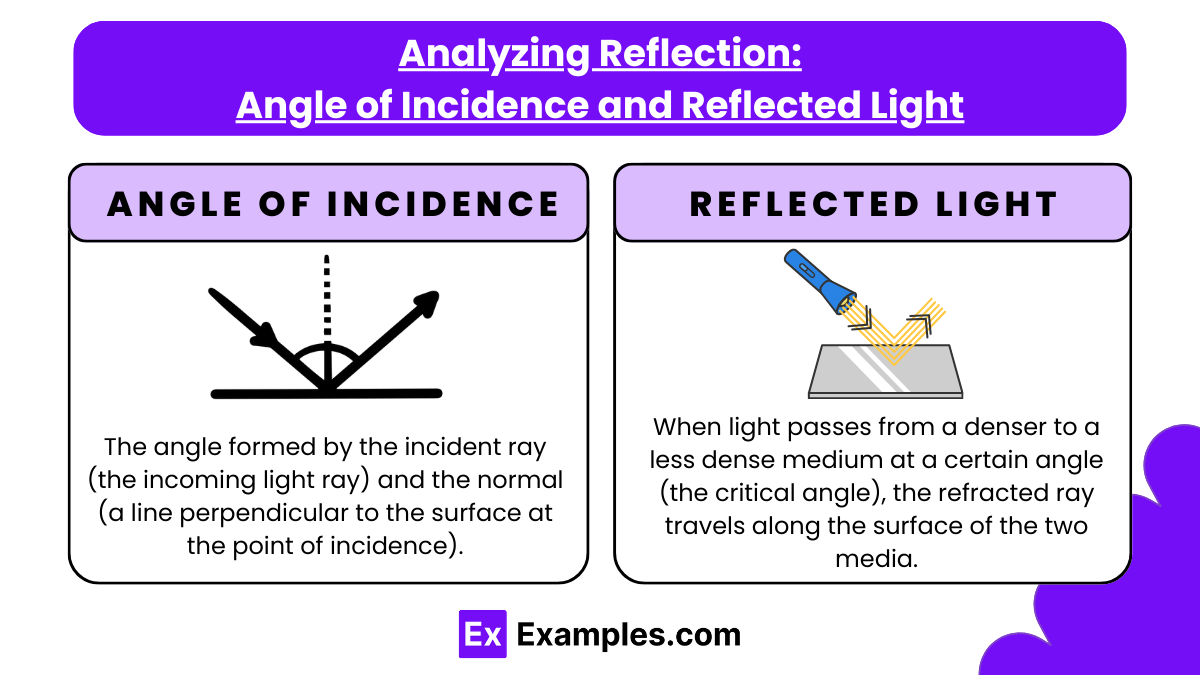
Analyzing how reflection works involves understanding the relationship between the angle of incidence and the angle of reflection, which are governed by the basic laws of reflection. This understanding is essential in many areas, including optical design, engineering, photography, and even safety in architecture and vehicle design.
Basic Principles of Reflection
Reflection occurs when light rays bounce off a surface. The behavior of these reflected rays is predictable and consistent, described by the following laws:
Law of Reflection:Spherical mirrors are mirrors with a reflective surface that is a segment of a sphere. They can be classified as concave or convex. understanding the properties of spherical mirrors, including image formation, focal length, and ray diagrams, is essential for analyzing optical systems and their applications in various scientific contexts.
Angle of Incidence: The angle formed by the incident ray (the incoming light ray) and the normal (a line perpendicular to the surface at the point of incidence).
Angle of Reflection: The angle formed by the reflected ray and the same normal.
According to the law of reflection: θincident = θreflected
This means the angle at which the light ray hits the surface will be equal to the angle at which it bounces off the surface.
Coplanar Principle:
The incident ray, the reflected ray, and the normal to the surface at the point of incidence all lie in the same plane.
Analyzing Reflection
To analyze reflection, particularly in an educational or experimental setting, you can follow these steps:
Set Up the Experiment:
Position a flat mirror on a horizontal surface.
Use a ray box or a laser pointer to direct a ray of light at the mirror.
Place a protractor or angular scale next to the mirror to measure angles.
Measure the Angle of Incidence:
Adjust the direction of the incoming light ray and measure the angle between this ray and the normal to the mirror's surface. This is your angle of incidence.
Observe and Measure the Angle of Reflection:
Observe the path of the reflected ray.
Measure the angle between the reflected ray and the normal, ensuring your measurements are taken from the same reference point (the normal).
Verify the Law of Reflection:
Check if the angle of incidence equals the angle of reflection. Any discrepancies can often be attributed to measurement errors or the setup's alignment.
Exploring Refraction: Change of Light’s Speed and Direction
Refraction is the bending of light as it passes from one medium into another with a different optical density (refractive index). This phenomenon occurs due to the change in the speed of light when it enters a medium of varying density. Understanding how light’s speed and direction change during refraction is fundamental in optics and is essential for designing lenses, prisms, fiber optics, and many other optical systems.
How Refraction Works
When light travels between two transparent media (e.g., air to water), part of it changes direction at the boundary. This change in direction happens because the speed of light depends on the refractive index (n) of the medium:
In a less dense medium (e.g., air), light travels faster.
In a denser medium (e.g., glass or water), light slows down.
If the light enters the new medium at an angle, this change in speed causes the light to bend, which is called refraction.
How Direction Changes: Snell’s Law
The mathematical relationship between the angles of incidence and refraction is given by Snell’s Law:
n1sinθ1 = n2sinθ2
where:
n1 = Refractive index of the first medium
n2 = Refractive index of the second medium
θ1 = Angle of incidence (with respect to the normal)
θ2 = Angle of refraction (with respect to the normal)
Behavior of Light Based on Refraction
When Light Enters a Denser Medium (e.g., Air to Water):
The light ray bends toward the normal.
n2>n1, so the speed of light decreases in the second medium.
Example: A pencil partially submerged in water appears bent at the water’s surface.
When Light Enters a Less Dense Medium (e.g., Water to Air):
The light ray bends away from the normal.
n1>n2, so the speed of light increases in the second medium.
Example: Light rays leaving a swimming pool seem to diverge, making objects under the water appear closer to the surface.
Critical Angle and Total Internal Reflection:
When light passes from a denser to a less dense medium at a certain angle (the critical angle), the refracted ray travels along the surface of the two media.
For angles greater than the critical angle, the light undergoes total internal reflection, meaning it is completely reflected back into the denser medium.
Impact of Refraction on Light’s Speed
Speed in Vacuum: The speed of light in a vacuum is approximately 3.00×108 m/s.
Speed in Other Media: In water, for example, light slows to about 2.25×108 m/s. In glass, it slows even more, to roughly 2.00×108 m/s.
The refractive index (n) is the ratio of the speed of light in a vacuum to the speed of light in the medium: n = c/v
where:
c = Speed of light in a vacuum
v = Speed of light in the medium
Applying Concepts to Real-World Scenarios
Rearview and Side Mirrors on Vehicles: Convex mirrors are used in side mirrors because they provide a wider field of view than flat mirrors, making it easier for drivers to see vehicles approaching from behind. The law of reflection ensures that the angle of reflection corresponds to the driver’s angle of view, helping avoid blind spots.
Periscopes: Used in submarines or observation decks, periscopes use two plane mirrors placed at 45° angles. The light reflects off both mirrors to allow the viewer to see over obstacles or from concealed positions.
Flashlights and Headlights: Concave mirrors are placed behind light bulbs to reflect and focus light into a directional beam, improving visibility over long distances, especially in car headlights and searchlights.
Corrective Lenses and Eyeglasses: Convex lenses are used to correct farsightedness (hyperopia), while concave lenses correct nearsightedness (myopia). The lenses refract incoming light to properly focus it on the retina, restoring clear vision.
Cameras and Binoculars: Lenses inside cameras and binoculars refract light to focus it on image sensors or eyepieces. Multiple lenses in a system help control distortions and improve image quality.
Magnifying Glasses and Microscopes: Convex lenses are used in magnifying glasses and microscopes to produce magnified images of small objects. Refraction helps increase the apparent size of the object, making it easier to study minute details.
Examples
Example 1: Mirrors and Personal Grooming
Mirrors are everyday examples of reflection, where light rays bounce off a smooth surface to form a clear image. When you look into a bathroom mirror, the light from your face reflects directly back to your eyes, allowing you to see your reflection. This principle of reflection is critical in various applications, including personal grooming and design.
Example 2: Lenses in Glasses
The refraction of light is the primary principle behind corrective lenses in eyeglasses. When light passes through the curved surfaces of the lenses, it bends to focus on the retina correctly. For instance, concave lenses are used to correct nearsightedness by diverging light rays, while convex lenses are used for farsightedness, converging light rays to improve vision.
Example 3: Rainbows
Rainbows are a beautiful example of both reflection and refraction occurring in nature. When sunlight enters a raindrop, it refracts, or bends, as it passes from air into the water, then reflects off the inner surface of the drop. As it exits the droplet, it refracts again, separating the light into its component colors and creating the spectrum of a rainbow.
Example 4: Optical Fibers
Optical fibers rely on the principles of reflection and refraction to transmit light signals over long distances. The core of an optical fiber has a higher refractive index than the surrounding cladding, causing light to refract into the core and reflect internally. This principle allows for efficient transmission of data in telecommunications and medical instruments, demonstrating practical applications of these optical phenomena.
Example 5: Underwater Viewing
When observing objects underwater, such as fish, the apparent depth of the object appears different from its actual depth due to refraction. As light travels from water to air, it bends, causing objects submerged in water to look closer to the surface than they really are. This effect is important for activities like fishing and underwater photography, as it influences perception and visibility.
Practice Questions
Question 1
What happens to light when it strikes a smooth, shiny surface?
A) It scatters in many directions.
B) It is absorbed by the surface.
C) It reflects in a uniform direction.
D) It refracts through the surface.
Correct Answer: C) It reflects in a uniform direction.
Explanation: When light strikes a smooth, shiny surface, such as a mirror or calm water, it reflects in a uniform direction. This is known as specular reflection, where the angle of incidence equals the angle of reflection. This uniform reflection allows for clear images to be formed, as seen in mirrors. Option A is incorrect because scattering occurs on rough surfaces, while option B is misleading since not all light is absorbed by reflective surfaces. Option D is also incorrect because refraction occurs when light passes into a different medium, not merely when it reflects.
Question 2
Which of the following statements about refraction is true?
A) Refraction occurs only when light enters a denser medium.
B) Refraction always results in the light bending away from the normal.
C) Refraction can change the speed and direction of light.
D) Refraction does not occur at the boundary between two different media.
Correct Answer: C) Refraction can change the speed and direction of light.
Explanation: Refraction occurs when light travels from one medium to another, such as from air to water, causing both a change in the speed of light and a bending of its direction. This bending happens due to the difference in optical density between the two media. Option A is incorrect because refraction can also occur when light enters a less dense medium, causing it to bend away from the normal. Option B is misleading as light can bend towards or away from the normal depending on the mediums involved. Option D is incorrect because refraction specifically occurs at the boundary between two different media.
Question 3
What is the primary reason we see a straw appearing bent when placed in a glass of water?
A) Reflection of light off the water surface
B) Absorption of light by the water
C) Refraction of light as it passes from air to water
D) Diffraction of light around the straw
Correct Answer: C) Refraction of light as it passes from air to water.
Explanation: The appearance of a straw being bent when placed in water is due to the refraction of light. As light rays travel from air (a less dense medium) into water (a denser medium), they bend at the water's surface, altering the perceived position of the straw. This optical illusion highlights the effect of refraction, which occurs when light transitions between media with different refractive indices. Options A and B do not explain the bending effect, and option D refers to a different phenomenon that does not apply to this scenario.

